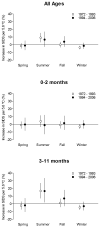Ambient Temperature and Sudden Infant Death Syndrome in the United States
- PMID: 28661937
- PMCID: PMC5552234
- DOI: 10.1097/EDE.0000000000000703
Ambient Temperature and Sudden Infant Death Syndrome in the United States
Abstract
Background: Sudden infant death syndrome (SIDS) is a leading cause of infant mortality in the United States. While thermal stress is implicated in many risk factors for SIDS, the association between ambient temperature and SIDS remains unclear.
Methods: We obtained daily individual-level infant mortality data and outdoor temperature data from 1972 to 2006 for 210 US cities. We applied a time-stratified case-crossover analysis to determine the effect of ambient temperature on the risk of SIDS by season. We stratified the analysis by race, infant age, and climate.
Results: There were a total of 60,364 SIDS cases during our study period. A 5.6°C (10°F) higher daily temperature on the same day was associated with an increased SIDS risk of 8.6% (95% confidence interval [CI] = 3.6%, 13.8%) in the summer, compared with a 3.1% decrease (95% CI = -5.0%, -1.3%) in the winter. Summer risks were greater among black infants (18.5%; 95% CI = 9.3%, 28.5%) than white infants (3.6%; 95% CI = -2.3%, 9.9%), and among infants 3-11 months old (16.9%; 95% CI = 8.9%, 25.5%) than infants 0-2 months old (2.7%; 95% CI = -3.5%, 9.2%). The temperature-SIDS association was stronger in climate clusters in the Midwest and surrounding northern regions.
Conclusions: Temperature increases were associated with an elevated risk of SIDS in the summer, particularly among infants who were black, 3 months old and older, and living in the Midwest and surrounding northern regions.
Conflict of interest statement
Figures






Similar articles
-
Ambient Heat and Sudden Infant Death: A Case-Crossover Study Spanning 30 Years in Montreal, Canada.Environ Health Perspect. 2015 Jul;123(7):712-6. doi: 10.1289/ehp.1307960. Epub 2015 Mar 6. Environ Health Perspect. 2015. PMID: 25748025 Free PMC article.
-
Is ambient temperature associated with risk of infant mortality? A multi-city study in Korea.Environ Res. 2017 Oct;158:748-752. doi: 10.1016/j.envres.2017.07.034. Epub 2017 Jul 24. Environ Res. 2017. PMID: 28750343
-
Bedsharing and maternal smoking in a population-based survey of new mothers.Pediatrics. 2005 Oct;116(4):e530-42. doi: 10.1542/peds.2005-0354. Pediatrics. 2005. PMID: 16199682
-
Sudden Infant Death Syndrome: A Review.Pediatr Ann. 2018 Mar 1;47(3):e118-e123. doi: 10.3928/19382359-20180221-03. Pediatr Ann. 2018. PMID: 29538785 Review.
-
[Sudden infant death syndrome (SIDS): risk conditions and intervention strategies].Minerva Anestesiol. 1994 Jul-Aug;60(7-8):393-402. Minerva Anestesiol. 1994. PMID: 7800187 Review. Italian.
Cited by
-
The Influence of Heat on Pediatric and Perinatal Health: Risks, Evidence, and Future Directions.J Clin Med. 2025 Feb 10;14(4):1123. doi: 10.3390/jcm14041123. J Clin Med. 2025. PMID: 40004654 Free PMC article. Review.
-
Temperature-related neonatal deaths attributable to climate change in 29 low- and middle-income countries.Nat Commun. 2024 Jun 29;15(1):5504. doi: 10.1038/s41467-024-49890-x. Nat Commun. 2024. PMID: 38951496 Free PMC article.
-
Metabolomic profiles of infants classified as sudden infant death syndrome: a case-control analysis.EBioMedicine. 2025 Jan;111:105484. doi: 10.1016/j.ebiom.2024.105484. Epub 2024 Dec 6. EBioMedicine. 2025. PMID: 39644771 Free PMC article.
-
Ambient Air Pollution and Sudden Infant Death Syndrome in Korea: A Time-Stratified Case-Crossover Study.Int J Environ Res Public Health. 2019 Sep 6;16(18):3273. doi: 10.3390/ijerph16183273. Int J Environ Res Public Health. 2019. PMID: 31489898 Free PMC article.
-
Racial Disparities in Climate Change-Related Health Effects in the United States.Curr Environ Health Rep. 2022 Sep;9(3):451-464. doi: 10.1007/s40572-022-00360-w. Epub 2022 May 28. Curr Environ Health Rep. 2022. PMID: 35633370 Free PMC article. Review.
References
-
- Mathews TJ, MacDorman MF. Infant mortality statistics from the 2010 Period Linked Birth/Infant Death data set. Natl Vital Stat Reports. 2013;62(8):1–33. - PubMed
-
- Moon RY. SIDS and Other Sleep-Related Infant Deaths: Expansion of Recommendations for a Safe Infant Sleeping Environment. Pediatrics. 2011;128(5):e1341–e1367. - PubMed
-
- Willinger M, James LS, Catz C. Defining the sudden infant death syndrome (SIDS): deliberations of an expert panel convened by the National Institute of Child Health and Human Development. Pediatr Pathol. 1991;11(5):677–684. - PubMed
MeSH terms
Grants and funding
LinkOut - more resources
Full Text Sources
Other Literature Sources
Medical

